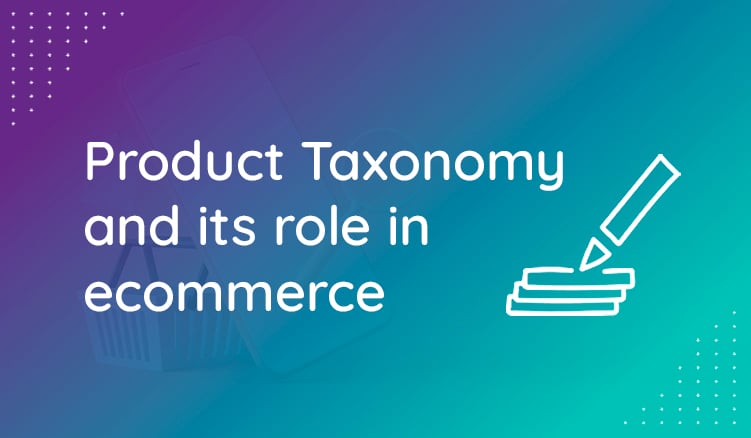Each product page on your website has a purpose: to convert. However, this is not easy to achieve when your product information is poorly organized and laid out.
Think about it. Google processes over 3.5 billion searches per day. Of that, 46% of them are product searches — why would a customer spend more than 8 seconds trying to find sneakers on your website if they could quite easily just go somewhere else? It’s like walking into a library and not being able to use a catalog. management system to find the book you want to read. Absolutely pointless.
A well-planned website taxonomy has the potential to transform your customer experience through improved content discovery, self-service, and digital commerce. (It’s also a painless way to manage large volumes of data. More so when it’s in a PIM system or product catalog management tool.) There is no one-size-fits-all. You have to categorize for your industry, audience, and search engines.
Here are some guidelines when creating and implementing taxonomies:
1. Keep your audience in mind
Taxonomies are customer-centric; you actually need to know who you’re selling to, what makes them click, and why they choose your brand. How do you do that? You seek information from them. Some ways include speaking to your customers, observing customer behavior in real-time, running user experience testing, analyzing shopper motives, and researching competitor trends. Remember, if customers cannot find what they want, they will drop off the page. Without this knowledge as your foundation, your taxonomies will not serve a purpose.
2. Really get to know your products
Not many retail brands understand the value of customer interactions. This level of customer intelligence comes with time: it requires constant research, testing, and insights. Understanding your products and the relationships they have with your customers is the secret to success in ecommerce. And to establish that, answer the following questions before you proceed with your taxonomy.
- What about your product offering excites your customers?
- How can you communicate these differentiators in your taxonomy structure?
- What type of language do customers use to search on your website?
- How do customers navigate your existing attributes?
If you cannot confidently answer these four questions, study your customers some more.
3. Base your taxonomies on language and location
Searching habits differ due to demographics, psychographics, and geographical location. The way a customer searches online is determined by a variety of factors, often far different from the way retailers think their customers would interact with their brand. From the above-mentioned groups, it is suggested that you segment your audiences. An obvious reason why would be for seasonal taxonomies on a multi-national website. The content results that appear need to be hyper-relevant to the customer’s profile for it to match their requirements. Another tip is to let your customers’ language determine your narrative. This will reduce the risk of creating complex taxonomies that are too broad or extensive for their liking.
4. What about those SEO keywords?
Search engine optimization is crucial for a successful ecommerce website.
Be it paragraphs of rich product descriptions or taxonomies; you need to perform on-page optimization by inserting high-volume keywords, phrases, or tags into your product content. This will help to position your website higher in search engines, inevitably increasing your visibility and sales opportunities.
To get started on this process, draw up a report on your best performing landing pages, blog, and products. Compare these search results with your keyword research to establish a common ground or list of relevancy going forward. The findings can then be incorporated into image alternative text, meta content, and URLs, and monitored on a regular basis. Bear in mind that you should avoid keyword stuffing at all costs, as it can lead to Google penalties and deranking.
5. Leave room for flexibility in content
Taxonomies cannot be set in stone; they’re an ongoing effort and can be tweaked. You will be required to change your approach in the near future or when you introduce new products to your site. If you have an extensive taxonomy structure, it is suggested that you implement it in stages. This will allow you to test and analyze each interaction before rolling out the rest. The same goes for incomplete taxonomies — you don’t want customers to visit categories with no content in them.
6. Implement, test, and test some more!
The motive for building a taxonomy needs to be about the consumer; it’s about adding a human element to their experience with your brand. The result, however, can lead to increased traffic and sales — only if the process has been tried and tested many a time. While it’s easier said than done, your structure needs to be functional, user-friendly, and personal. It must also support Google’s Best Practice Guidelines. What you’ve created might look promising on paper, but you’ll never know the impact unless you do on-site behavior testing.
If, for example, a customer is bottlenecked on a product page, you will see that in the conversion, exit, and bounce rates. Take note of these issues and try again.
7. Keep a record of governance
When taking notes of product taxonomy interactions, govern this data.
Over time, you will come across interesting actions, ones that many employees at your organization would not have expected to see from their point of view. This knowledge forms a solid foundation for improvement. The more you review this process, the closer you will get to customer experience excellence.
8. Unify the result across all touchpoints
When you have established a structure with positive engagement, roll it out across every digital touchpoint. This way, internal teams managing product information or syndicating content to different marketplaces and sales channels all have a shared understanding of the language you want to be using. Wherever your business has a presence, it needs to be uniform. Customers look at a brand, its social platforms, and its sales channel as a whole. Make sure you’re aligned.
In conclusion
A Product Information Management (PIM) system brings all these taxonomy components together in a single source of truth. With Plytix PIM, you can centralize, optimize and distribute content in a matter of minutes, speeding up time to market by 400% and increasing sales by up to 50%. To find the right PIM solution for your needs, download The Ultimate PIM Buyer's Guide.
Start using Plytix for free and let our friendly PIM experts show you the ropes!





